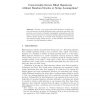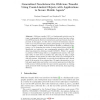659 search results - page 26 / 132 » Compiling and securing cryptographic protocols |
114
Voted
ASIACRYPT
2010
Springer
14 years 10 months ago
2010
Springer
We design cryptographic protocols that recognize best case (optimistic) situations and exploit them. As a case study, we present a new concurrent zeroknowledge protocol that is exp...
112
Voted
TCC
2007
Springer
15 years 6 months ago
2007
Springer
Abstract. We show a new protocol for blind signatures in which security is preserved even under arbitrarily-many concurrent executions. The protocol can be based on standard crypto...
116
Voted
ISICT
2003
15 years 1 months ago
2003
: Cryptographic protocols are used to achieve secure communication over insecure networks. Weaknesses in such protocols are hard to identify, as they can be the result of subtle de...
105
Voted
CCS
2010
ACM
14 years 10 months ago
2010
ACM
We address the insecurity problem for cryptographic protocols, for an active intruder and a bounded number of sessions. The protocol steps are modeled as rigid Horn clauses, and t...
118
Voted
FC
2008
Springer
15 years 2 months ago
2008
Springer
Oblivious transfer (OT) is a fundamental primitive used in many cryptographic protocols, including general secure function evaluation (SFE) protocols. However, interaction is a pri...



